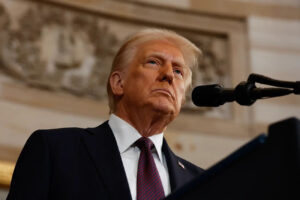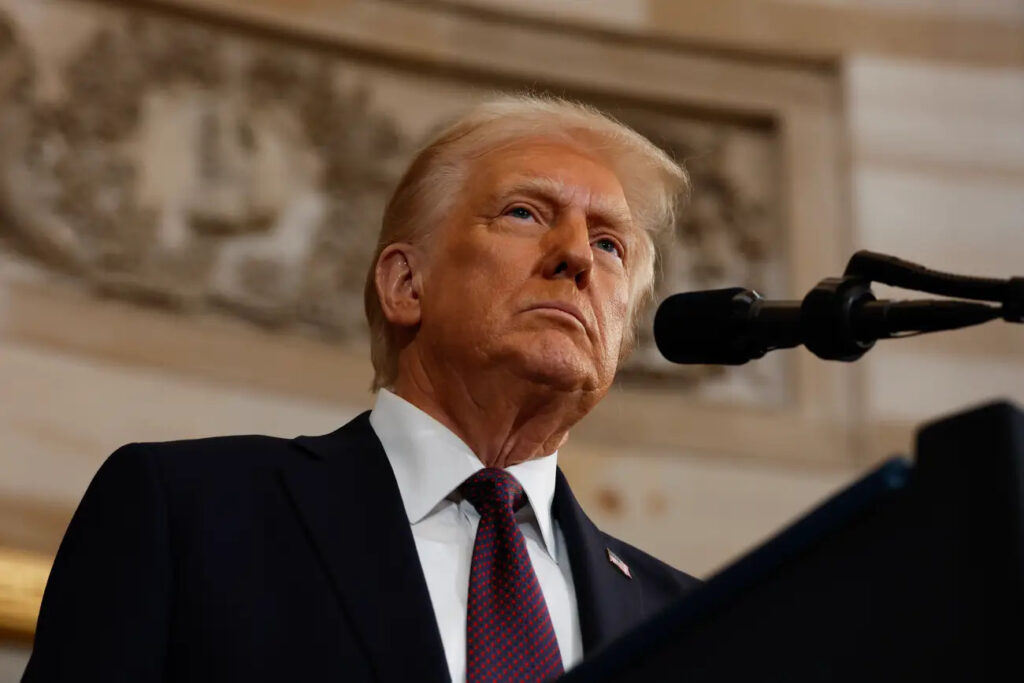🎧 Listen to This Article
On February 21, 2025, U.S. President Donald Trump took bold action that could reshape global trade—ordering his trade chief to revive investigations into imposing tariffs on countries taxing U.S. tech giants with digital service taxes (DSTs). Are you a business leader or tech executive bracing for higher costs in 2025? This U.S. 2025 tariff retaliation on digital service taxes could impact your bottom line today, February 22, 2025—here’s what you must know to protect your business.
What’s Driving Trump’s Tariff Retaliation?
During a business session with U.S. governors at the White House on February 21, 2025, Trump directed the U.S. Trade Representative (USTR) to renew Section 301 investigations from his first term, targeting DSTs imposed on dominant U.S. tech companies like Alphabet’s Google, Meta’s Facebook, Apple, and Amazon. A White House official declared, “President Trump will not allow foreign governments to appropriate America’s tax base for their own benefit,” signaling tariffs as a key weapon against these taxes.
DSTs—levied on sales revenue by digital service providers—have long frustrated U.S. administrations. Posts on X from February 21, 2025, reflect mixed sentiment: some tech advocates decry the taxes as unfair, while others worry about escalating trade tensions, but many support Trump’s retaliation stance.
Which Countries Are Targeted?
Nations imposing DSTs, including Britain, France, Italy, Spain, Turkey, India, Austria, and Canada, are under scrutiny. These countries have collected over $2 billion annually in DST revenues, with Canada and France each raising more than $500 million, per a White House fact sheet. Trump previewed tariffs on goods from Canada and France last week, a move echoed in web reports of broader U.S. tariff strategies against Mexico, Canada, and China, raising fears of retaliation.
Key Actions in Trump’s February 21 Memo
Here’s what Trump’s order, effective as of February 22, 2025, entails:
- Tariff Retaliation: The USTR will consider tariffs to counter DSTs, fines, and policies discriminating against U.S. firms, reviving 2021 plans for 25% tariffs on $2 billion in imports from six countries (e.g., $887 million from Britain, $386 million from Italy). Trump didn’t specify rates or goods yet, but historical actions suggest broad impacts.
- EU and UK Policy Review: The memo mandates scrutiny of EU and UK policies, like the Digital Markets Act and Digital Services Act, to ensure they don’t undermine U.S. free speech or foster censorship, amid reports Google faces EU charges for breaching the Digital Markets Act.
- Global Tax Exit: On January 20, 2025, Trump withdrew the U.S. from a 15% global corporate minimum tax agreement with 140 countries, halting DST alternative talks, per web reports on his “America First Trade Policy.”
This builds on Trump’s broader tariff strategy, including 10% on China (effective February 4, 2025) and delayed 25% on Mexico/Canada (now March 1, 2025), per recent trade news, risking a global trade war.
Historical Context and Economic Risks
During Trump’s first term, USTR found DSTs discriminated against U.S. companies, enabling retaliatory tariffs. In 2021, Biden’s trade chief Katherine Tai suspended tariffs to negotiate a global tax deal, but it failed when Congress didn’t ratify the 15% minimum tax. Web reports warn tariffs could raise U.S. prices, disrupt supply chains, and invite retaliation (e.g., China’s 10–15% on U.S. exports), echoing 2018–2019 trade wars that hurt GDP by 0.2%, per tax policy analysis.
“What they’re doing to us in other countries is terrible with digital,” Trump told reporters on February 21, 2025, reflecting frustration shared on X, where users debate economic costs versus U.S. protectionism.
What This Means for Your Business in 2025
Wondering, “How will U.S. tariffs on digital taxes affect my company?” or “What should I do if my country has a DST?” Here’s your urgent action plan:
- Monitor USTR Updates: Track investigations and potential tariff rates (e.g., 25% on $2B imports), due by April 30, 2025, via USTR.gov.
- Assess Supply Chain Risks: If you operate in DST-imposing countries or import/export goods, review costs and prepare for disruptions—web reports highlight higher prices for U.S. imports like electronics and autos.
- Evaluate EU/UK Compliance: Tech firms should assess Digital Markets Act and Digital Services Act impacts on free speech and operations, using EU Tech Regulation Guide.
A Turning Point for Global Trade
On February 22, 2025, this order signals a new era of trade tension, potentially raising costs for U.S. consumers and inviting countermeasures from affected nations. “Tariffs protect American innovation,” a White House official noted, but economists warn of inflation risks, per NPR and Tax Foundation reports. For businesses, swift action is essential to mitigate impacts.
For further details, clarification, contributions or any concerns regarding this article, please feel free to reach out to us at editorial@tax.news. We value your feedback and are committed to providing accurate and timely information. Please note that all inquiries will be handled in accordance with our privacy policy

